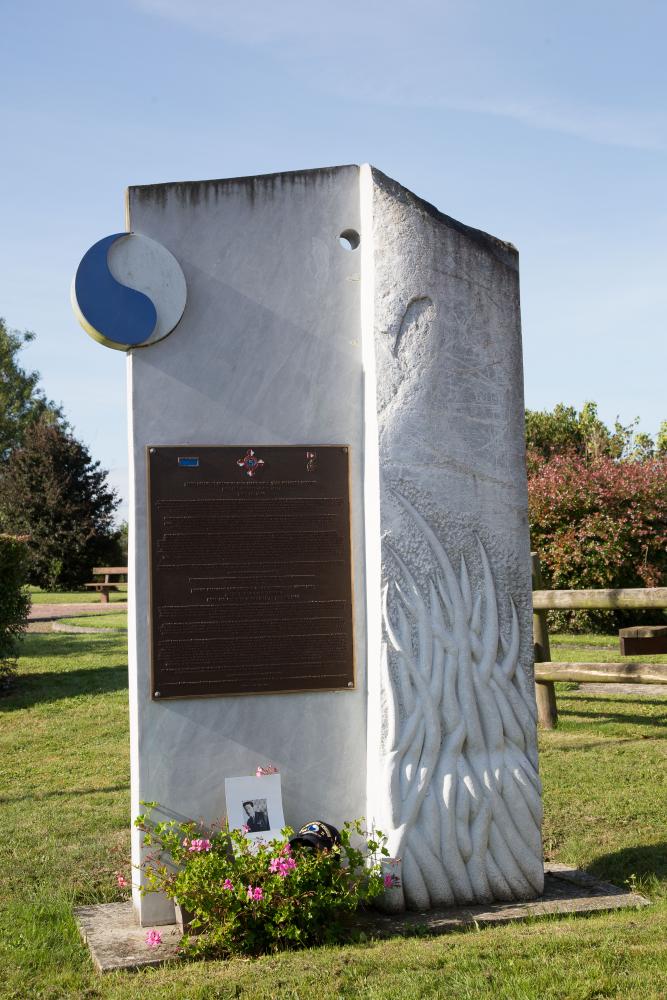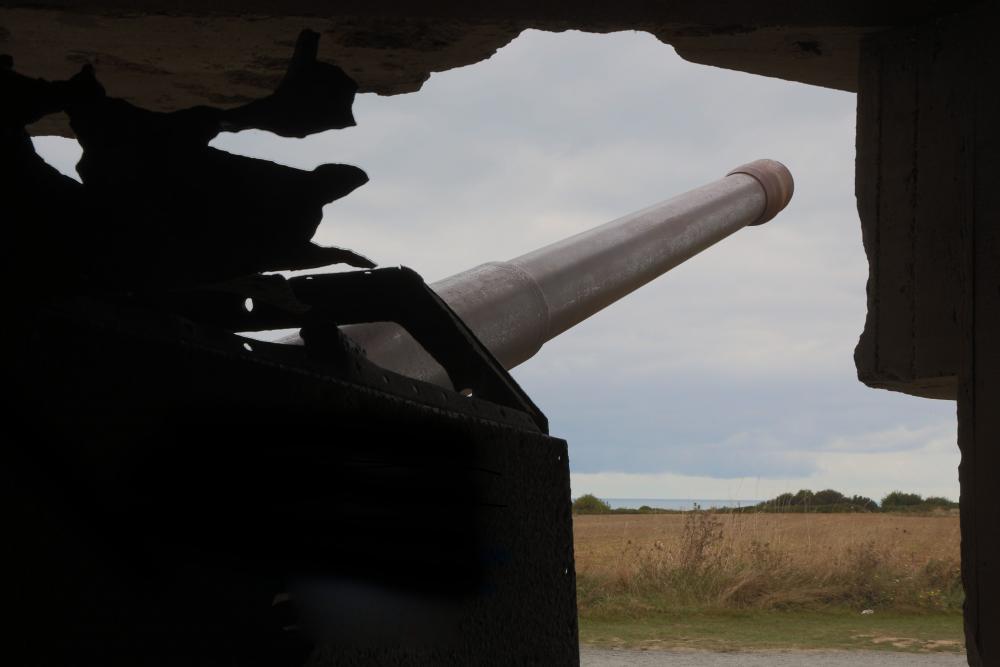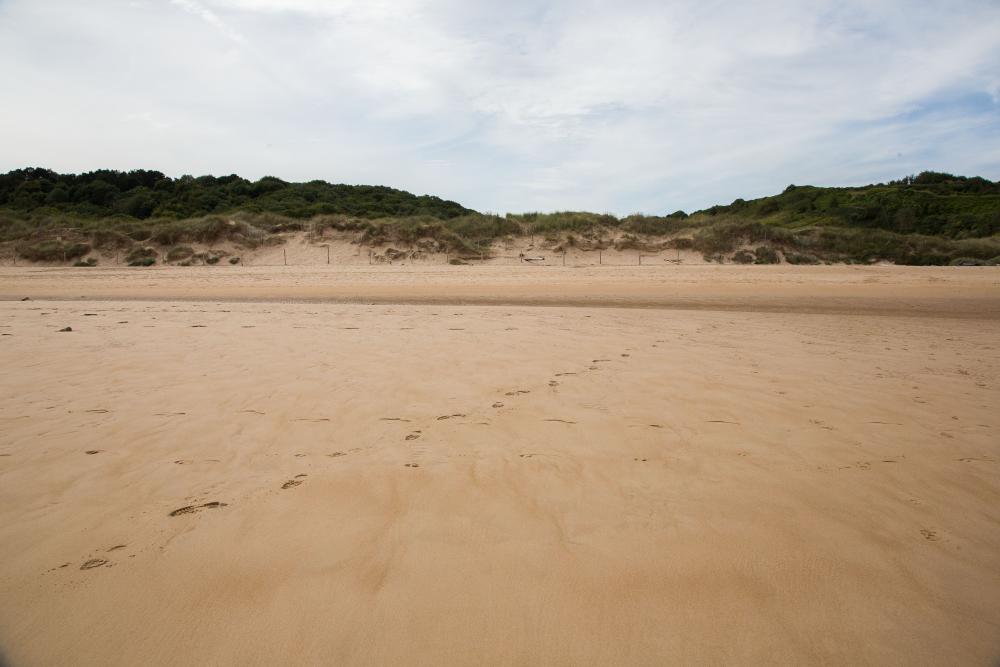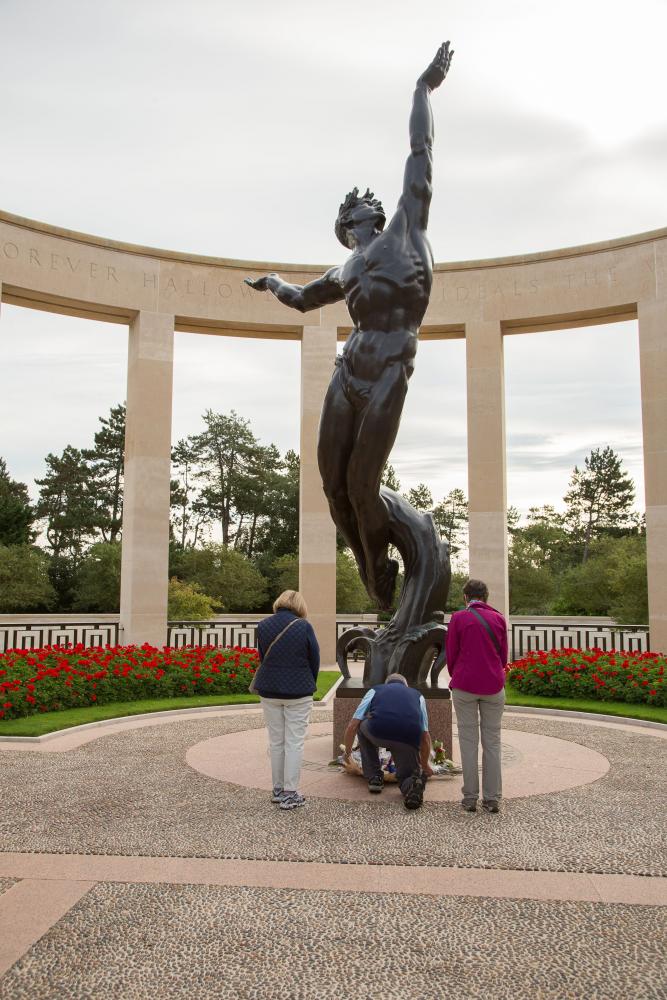Esther and I spent last week visiting the beaches and battlefields of Normandy where Allied forces landed on D-Day, June 6, 1944. Several in our group of 30 travelled here for the same reasons, to see where their fathers landed and fought to liberate Europe. For all of the sons and daughters, the trip was an emotional one: realizing the dangers their fathers faced and the continuous combat they experienced month after month, and wishing that they had known sooner what heroes their fathers were. None of the fathers talked to their children about these experiences, they bore and suffered with their memories and feelings in silence.
Esther’s father, Pfc Raymond Stednitz, did write a memoir of his life, and from that and our own research we were able to reconstruct some of what happened after he landed on Omaha Beach with the 29th Division as part of the D-Day invasion. Born in Hoboken, NJ, Esther’s father worked two jobs after school to support his single mother and older brother. He became a carpenter and at 21 years old was working as a shipfitter at the Brooklyn Navy Yard when war was declared. He never expected to go to war when he joined the New Jersey National Guard in 1940, but when his unit was mobilized in 1941, he refused the deferment he was offered by the Commandant of the Navy Yard, writing later that “I decided to spend the next year with the guys I knew.”
Though her father was from New Jersey, on arriving in England he was assigned to the 175th Infantry, a Maryland National Guard regiment known as the 5th Maryland before World War II. Soldiers of the 5th Maryland served with distinction on both sides in the Civil War, inspiring the blue and gray shoulder patch of the 29th Division. Esther’s father may well have served with soldiers whose children read the Spy.
Esther’s father was assigned as a machine gunner to Company D, the heavy weapons company of the 1st Battalion, 175th Infantry. From Omaha Beach they first liberated Isigny and then advanced through the infamous hedgerows of Normandy toward their objective of Saint Lo, and we followed their path.
Driving down the lanes of Normandy revealed the dangers Esther’s father and his fellow soldiers faced. The road and fields were still bordered by high banks topped by thick hedges, all of which could conceal a waiting German ambush. Their progress was measured by the number of hedges they survived to cross in a day.
We stopped in the tiny village of Villiers Fossard to visit a monument commemorating a celebrated battle in which Esther’s father fought. The monument was erected by veterans of the 29th Division from Baltimore, to honor the soldiers of the 175th who defended Hill 108, thereafter known as Purple Heart Hill, in a twelve-hour engagement on June 18, 1944.
The 1st Battalion, in which Esther’s father served, was leading the 29th Division’s advance on St Lo. The monument told their story: “At 8:30 AM June 18, the enemy initiated a severe artillery bombardment followed by a strong counterattack against the 1st Battalion. Heavily outnumbered, [they] stalwartly held their ground. Nearly surrounded, running low on ammunition, and out of communication with its supporting artillery unit, … the Battalion held on for more than twelve hours of combat at point blank range…. By dusk, the 1st Battalion had suffered more than 200 casualties, but had yielded not a foot of ground.”
Along with his fellow defenders of Purple Heart Hill, Pfc Stednitz received a Presidential Unit Citation and the French Croix de Guerre with silver gilt star, and possibly one of his two Purple Hearts. Esther reflected that “until we pieced this story together, nobody in my family knew what my father did. I didn’t know that his pride in my becoming a Lieutenant in the Navy Nurse Corps was recognition from a real hero. I wish I could tell him how I feel today.”
The 175th Infantry Monument

Pfc Stednitz then fought his way past Paris, through Belgium north of the Battle of the Bulge, and joined in the race through Germany to prevent Russia from occupying Germany west of the Elbe. He served from the declaration of war to its end in Europe. His first child was born just before he shipped out to England, and was two by the time he saw his father again.
Esther remembers her father as a man who took care of his family with the same self-sacrifice he showed in refusing a deferment to stay with his National Guard buddies when they were called up. “He didn’t have an easy life, but every morning he made breakfast for us, he took us to school, girl scouts and all our other activities. We complained about our frequent trips to New York for parades, museums and especially the planetarium, but he made sure we had a good life no matter what it cost him.”
Lynne Richardson also came to see where her father fought. She and her husband also pieced his story together from Army records. He was 2nd Lt. James Melancon, and he commanded the 3rd Platoon, Company F, 2nd Battalion, 8th Infantry Regiment, 4th Infantry Division in Normandy. Coming from a family of 13 children in St James, LA, he was accepted at LSU and joined the ROTC. His study of agricultural economics was interrupted early in the war, when all the ROTC cadets at LSU were sent to Officer Candidate School on Fort Benning, GA. The 4th Division arrived in England on January 26, 1944, on their way to France.
Lt Melancon landed with the 2nd Battalion of the 8th Infantry, leading the assault on Utah Beach. They moved out rapidly to the west to secure the harbor of Cherbourg. After fighting their way to Cherbourg, they turned south and joined up with Patton’s Third Army to break out from the Normandy Coast and start pushing German forces back out of France.
German Gun Emplacement Overlooking the Beach

Still in the hedgerows on August 7, the 2nd Battalion was heading toward the German counterattack at Mortain. Company F was assigned to clear the road toward the German Panzer divisions, and Lt Melancon’s platoon led the advance down the road with the rest spread out in the fields. They were stopped by a minefield which they knew to be defended by retreating German units. Nevertheless, he was ordered to send a squad to determine what enemy weapons were covering the minefield.
Lt Melancon insisted on joining the squad, and not far down the road they were attacked by German machine gun fire, tanks and mortars. Most of the squad were killed or wounded, and the casualties lay in the road until the next morning. When the road was finally cleared by a tank battalion, Lynne’s father was found seriously wounded.
That was the end of the war for Lynne’s father. He spent months in hospital in England, and was awarded the Silver Star for his leadership, courage and disregard for his own safety. After the war he returned to LSU to finish his degree.
Lynne told me that “Dad suffered greatly from survivor guilt, and always questioned why he came home when so many others didn’t. To some questions, there are just no good answers. I just know that my mother and 5 siblings are grateful for his life and what he taught us.”
The father of another of our companions, Bruce Blackford, was a farmer in Loveland, CO when he was drafted. He was assigned to the 104th Infantry Division (known as the Timberwolves) and rose to the rank of First Sergeant before landing near Cherbourg on September 7.
On November 16, the 104th was pushing toward Germany under heavy resistance. His unit had nearly reached Cologne, and was fighting in Eschweiler on November 21 when First Sergeant Blackford was hit by mortar fire. He was transported to a hospital in England, with his war over. Like the others, Bruce’s father did not want to talk about the war. Bruce commented that he always honored his father for what he did and wanted to learn more about his service. “But seeing what the soldiers in the first wave encountered and overcame on the beaches of Normandy, I am in awe of them.”
Some members of our group remembered other relatives who landed at D-Day. One had an uncle who was a medical doctor from New York. He enlisted in 1943 at the age of 39. He survived, but we saw memorials of other doctors who were killed during the Battle of Normandy while treating wounded soldiers.
In the course of the trip we saw the wide stretches of sand at Omaha and Utah Beaches that our fathers crossed through obstacles and heavy fire, the German gun emplacements they had to destroy, the cliffs and steep slopes up which they fought, and in Point-du-Hoc the craters that were left to show how fierce the battle was. We drove through the hedgerows where Pfc Stednitz and Lt Melancon advanced, and could see how completely they hid the German troops waiting in ambush.
How Far It Was Across Omaha Beach

We also spent time at the many monuments dotted along the Normandy Coast. Point du Hoc honored the Rangers who scaled the cliffs to silence German guns enfilading Utah and Omaha Beach, one monument at Omaha Beach honored the 1st and 29th Divisions th
at led the way, another honored all the green National Guard units that landed in Normandy, and on to Gold, Sword and Juno Beaches where British and Commonwealth divisions landed.
We visited the Normandy American Cemetery and Memorial above Omaha Beach toward the end of our time in Normandy. Esther, Lynne and our senior officer present, Joe Sychterz, laid a wreath at the memorial, remembering and honoring their fathers who survived as well as the 31,744 allied soldiers who died in the battle of Normandy.
Everyone I saw had tears in their eyes during the wreath-laying ceremony. The tears were for the 9,387 soldiers who lay in the graves in Colleville-sur-Mer and the 1,557 whose bodies were never found. They were also tears of gratitude that their fathers and family members had come home to them. Lynne summed up her feelings as “Even more gratitude that Dad had survived. Even more sadness for all those who did not.”
Wreath Laying at the American Cemetery in Normandy
 Throughout our visit, we were continually impressed and touched by how France has honored the men who died. Normandy itself paid a high price for the liberation of Europe, with two-thirds as many civilians killed as Allied soldiers and airmen. Almost no buildings built before 1944 were standing in the cities of Normandy that we visited. Caen, Saint Lo, Le Havre and other cities were leveled by Allied bombers in the weeks prior to D-Day, to slow German reinforcements and supplies from reaching Normandy, and what remained was destroyed in the protracted battles to drive out the Germans. Showing their solidarity in suffering, the Normans erected a memorial to those who died on 9-11 at a 12th century church in Bayeux that we visited shortly after September 11.
Throughout our visit, we were continually impressed and touched by how France has honored the men who died. Normandy itself paid a high price for the liberation of Europe, with two-thirds as many civilians killed as Allied soldiers and airmen. Almost no buildings built before 1944 were standing in the cities of Normandy that we visited. Caen, Saint Lo, Le Havre and other cities were leveled by Allied bombers in the weeks prior to D-Day, to slow German reinforcements and supplies from reaching Normandy, and what remained was destroyed in the protracted battles to drive out the Germans. Showing their solidarity in suffering, the Normans erected a memorial to those who died on 9-11 at a 12th century church in Bayeux that we visited shortly after September 11.
Our final stop was at the World War II museum in Caen. It was an intense reminder of what the fighting was about. The Nazi atrocities documented there made it clear what our fathers accomplished and why France has continued to remember them. The pictures of 11,000 Jewish children rounded up and sent to their deaths by the French collaboration government were particularly horrifying. We learned in Paris that all but one of the leaders of that government were executed after the war.
The photos and records of fighting in the museum provided graphic documentation of the price our fathers paid. As Esther put it, “My one regret is that I did not ask him, ‘Dad, what was it like?” I see him now with a different set of eyes, and wish I had known what to ask to hear his story. We will all be changed forever by what we learned here.”
Lt Melancon, Pfc Stednitz and Pvt Blackford did not come from privileged backgrounds. Yet they did not portray themselves as victims or give in to resentment at being asked to serve. Certainly they groused and complained like soldiers throughout history. Nevertheless, they stepped forward willingly, then returned hurt emotionally and physically to take their place as breadwinners for their families, treasuring the country they fought for and respecting its flag.
We also reflected that we and our children, nieces and nephews belong to the last generations who knew those men. Before very long there will be few children of the men who landed in Normandy still alive. The average age of our group was around 70, and after we are gone only the memorials and stories will remain to remind our descendants of what was accomplished here, by very ordinary men who went willingly when called and carried our flag into a foreign land to liberate it from evil.
Our group spanned the political spectrum, but those differences were submerged in our common feelings about our experiences. All of us felt some kind of obligation to be here, to follow fathers’ steps, as the culmination of years of study of D-Day, to honor fellow men-at-arms, or to understand what happened. We believed it was an honor and privilege to see these scenes. Even though we started out strangers, each felt the others pain and sorrow, be it for the loss of fathers who came home but never spoke of their pain or for those who still lay in France. We came to see for ourselves the beaches and fields of Normandy, and we also experienced a time of unity that transcended political parties.
I believe all of us who visited Normandy want to keep on telling this story so that it may not be forgotten and that our country may honor and try to emulate the virtues shown there.
David Montgomery is retired from a career of teaching, government service and consulting, during which he became internationally recognized as an expert on energy, environmental and climate policy. He has a PhD in economics from Harvard University and also studied economics at Cambridge University and theology at the Catholic University of America, David and his wife Esther live in St Michaels, and he now spends his time in front of the computer writing about economic, political and religious topics and the rest of the day outdoors engaged in politically incorrect activities.



Howard Freedlabder says
As a longtime member and officer of the Maryland National Guard, I got know many of the 29th Infantry Division veterans who fought on Bloody Omaha Beach in June 6, 1944. They were proud men, ordinary men who faced terrible odds as they withstood unceasing fire from German soldiers ensconced on the bluffs overlooking this now serene beach. They spoke little and cried less about their exploits and lost comrades. They returned and rebuilt America. They were understated heroes. Few are left.